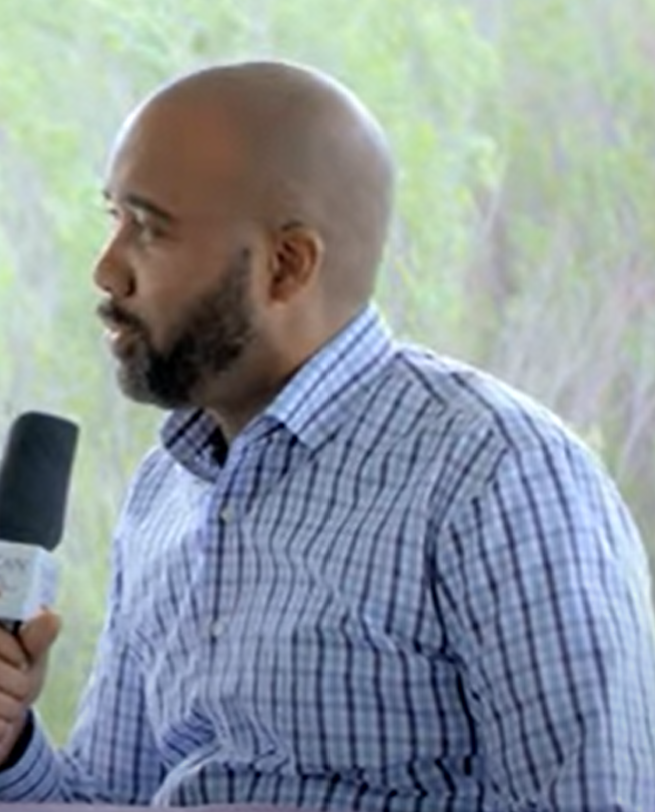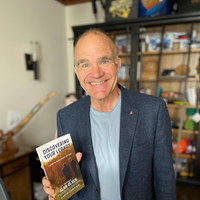Episode Transcript of: Raamel Mitchell
Alan Olsen: I’m here today with Raamel Mitchell from Microsoft welcome.
Raamel Mitchell: It’s great to be here with you Alan.
Alan Olsen: So Raamel for the listeners, can you give the background of your work experiences start from college on and how you got to where you are today and what are you currently doing at Microsoft?
Raamel Mitchell: So I, I have a degree in electrical engineering and a minor in physics from Tuskegee University. It was a field that I really was passionate about. My father majored in mathematics minor in physics, my brother majored in electrical engineering. And so for me, it just felt as though it was a natural thing to do. My, my other studies included a MBA from Georgetown and another MBA. It’s a dual MBA program from a SATA University in Barcelona. And so that’s basically my educational background. And today, I’m the Public Affairs Director, citizenship director from Microsoft, our US citizenship team for the central us and our Managing Director for a los curliness campus in Dallas. So no, there’s a lot in it a title. But that’s, that’s kind of where I am today.
Alan Olsen: There’s a lot of transformation in technology. And how is Microsoft responding to what’s currently happening in our industry today?
Raamel Mitchell: Yeah, that’s, that’s actually a very good point. And there is a ton of transformation that’s occurring. In fact, over the last five years, 10 years, we’ve seen a tremendous amount of transformation that’s taking place. If we go back just a bit, we would say that it started with the cloud. Back when the cloud was a nebulous term, where people were still trying to figure out what the cloud was, I think we’ve all kind of understood that we understand the power of where the cloud is, and where we can go. Today, we are a company that is not just a software company or cloud company, but a company that is also very focused on AI. The way that I like to think about it is that as we think about the power, leveraging the power of the cloud, leveraging, leveraging the power of data, and the impact that data will have on transforming business, transform the education, transforming the way in which we get from point A to point B, how we shop, how we move, how we connect with our friends and family, how we recall memories. All of this is a data driven society. And so to your question, I think one of the things that we’re thinking about is that in this age of digital transformation, how can we leverage artificial intelligence machine learning to, to continue improving the lives of individuals and communities, but also to improve operational efficiencies for organizations and companies that are small or are very large, whether you’re a startup, or whether you’re a fortune 10? You know, you will, we’re seeing that this has a power to transform all of those companies, all of those organizations. And so it’s, it’s been an interesting journey, over the last 1015 years, or over the last 16 years since I’ve been with Microsoft to see this transformation take place, both in the industry and in the company.
Alan Olsen: When we look at Microsoft and thinking about historically It started off with the operating system on a PC, moving over to the cloud, and then we see like office 365. And, you know, basically the consumer portion of it. But Microsoft goes a lot deeper, don’t they?
Raamel Mitchell: Yeah, Microsoft does go a lot deeper, and I was just at was just in Seattle last week at the on a Redmond campus. And, you know, it’s funny that you mentioned how we start I was, you know, I was looking at the, the Altair, which is the machine where Bill Gates and Paul Allen first designed the OS for right when they were in Arizona. And we’ve come a long way. In fact, the first vision for Microsoft was a computer on every desktop. And now we’re really a computer in every pocket, if you think about it. And so whether you have a cell phone, or you have a smart device, or you have a connected device, or something, or even a car, all of these devices that we have are connected to the cloud are connected to, you know, computing power that we could just imagine. And so where we are today, we really are thinking about where will the next 10 or 15 years or 20 years be in terms of our Microsoft Research and Development we spend we invest quite a bit of time, energy effort and resources. In Microsoft r&d, where we’re asking these questions about, well, how will AI be utilized? We think about cognitive services that can that could be leverage, we think about augmented reality and virtual reality, and how that can be leveraged in, in, in an organization or even in the consumer space. And so we’ve gone from a company that was thinking about a PC on every desktop, to knowing the power of a device in every pocket, to now everything being a device, which is insanely crazy when you think about it. Meaning that today, if you get into your car, you go out that car might be connected to whatever system, if you get into let’s say, I’m just going to throw out like a test lower, you know, some of the other electric vehicles that are out here. That is a smart autonomous vehicle that requires all of these systems and tools in order to manage it. But not only is it a smart autonomous system, but even when we think about the manufacturing process that it takes to build anything I was with the with the company a few weeks ago on their factory floor, a large manufacturing company. And the thing that they were thinking about was, how do they start automating and leveraging robotics in a way that they never have before now? 1980s, of course, we started in the US really thinking about how do we use robots and robotics, I think now with micro robots with various other technologies, where we can have a high density manufacturing facility, if you will, to basically enable the entire product chain, that that that product lifecycle, we’re thinking about all of that we’re thinking about logistics, we’re thinking about that individual that has to now be skilled in a way that maybe five years ago or even two years ago or even last month, they didn’t have to think about retail when we’re looking at the 5g networks going in.
Alan Olsen: Yeah. How is Microsoft planning or strategically looking at that, in integrating into their products?
Raamel Mitchell: You know, again, I think it’s an opportunity to, it’s not necessarily just looking at the integration into our products, but looking at this as another opportunity for us to leverage some of the other systems tools and technologies that that exists, but enhancing those capabilities. And so when we think about remote learning, or distance learning, or we think about telemedicine, or we think about research, or research environments, the ability to leverage micro machine learning, both at a local at a local level or in a large computing environment. What 5g will be able to do is enhance all of those capabilities, right or the goal of 5g is to be able to do that we heard this with 3g, we heard this before GU 5g, I think what we’re going to be able to do was really see a lot of these systems come to life. This is the 50th anniversary of Apollo coming up next week, Apollo, I think it’s on the 16th or the 19th. And a few weeks ago, Well, a couple of months ago, I had an opportunity to talk to Buzz Aldrin, and Charlie, Charlie do can walk Cunningham. And the funny thing about talking to those guys, they’ll say, you know what, we landed on the moon with 4k, of computing power, 4k. Today, we have more we have more computing power, most of our pencils, right? particularly our stylus that we use, right on our on our laptops or on our tablets. And so when we think about 5g, when we think about AI, artificial intelligence, when we think about machine learning, when we think about the future of work, work is fundamentally going to change. Our office environment will fundamentally change our educational environment will fundamentally change our ability to research. Things like genomics, genetics, or what have you will fundamentally change. And so 5g, again, another technology that will enable some of this to take place in real time in ways that we can’t even imagine right now. And so as we think about our investments in research and development, which is round 10 billion a year, we think the next 15 to 20 years ahead in terms of where the market be? where are some of the crazy ideas that we need to think about that could actually land the How could they be incorporated moving forward? And where’s the technology going? The other side of your question, though, I want to also just kind of addresses that, as we start, you know, leveraging tools like AI and, you know, we’re also as a company, thinking about the idea of digital ethics, right? When you’re starting corporate AI, we start thinking about skills and the skills that are necessary to succeed for today’s work or so all of those are part of our planning and part of our strategy from a
product development standpoint, as well as a human standpoint, right and so that’s what we look at.

To receive our free newsletter, contact us here.
Subscribe our YouTube Channel for more updates.
This transcript was generated by software and may not accurately reflect exactly what was said.
Alan Olsen, is the Host of the American Dreams Show and the Managing Partner of GROCO.com. GROCO is a premier family office and tax advisory firm located in the San Francisco Bay area serving clients all over the world.

Alan L. Olsen, CPA, Wikipedia Bio




